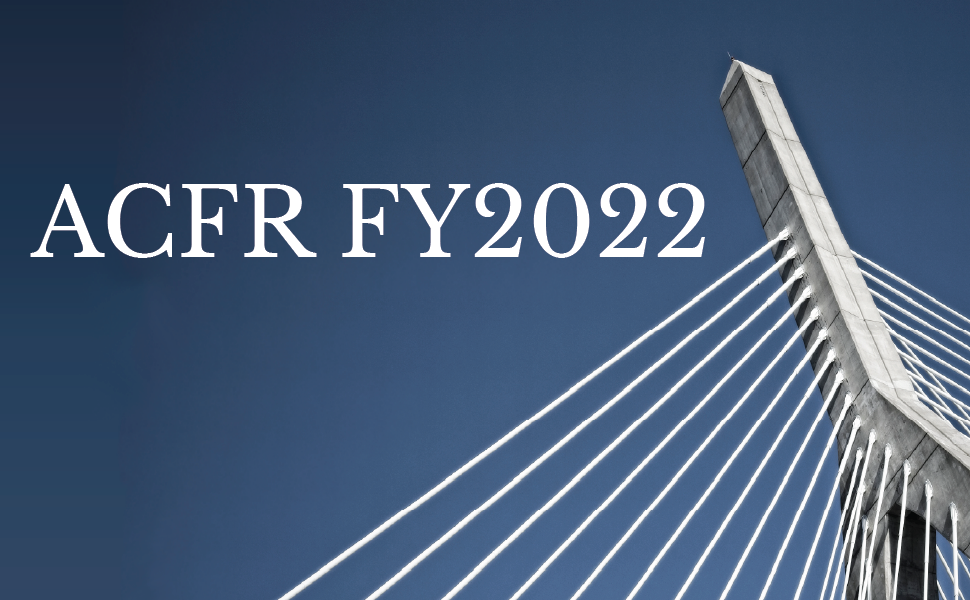Among the major highlights published in the ACFR:
- The total “government-wide” or “primary government” net position (which includes business-type activities of unemployment insurance, paid family and medical leave, and higher education) stood at a deficit of $67.424 billion as of June 30, 2022, a decline in the net deficit of $8.374 billion. Major reasons for this deficit include debt issued by the Commonwealth for road/bridge assets owned by the Massachusetts Department of Transportation (MassDOT), capital grants and expenditures for state authorities and municipalities, Massachusetts School Building Authority debt/grants payable, and unfunded pension and retiree health benefits.
- The Commonwealth’s current assets increased by $7.644 billion during Fiscal Year 2022, primarily as a result of increased cash on hand due to strong tax revenue growth as the Massachusetts economy continued to recover from the COVID-19 pandemic.
- The Commonwealth’s net pension liability (net of deferrals) decreased by $1.109 billion, primarily due to strong financial market performance in Fiscal Year 2021.
- Total revenues of the primary government decreased by $692 million, or 0.7%, to $91.731 billion, with strong tax revenue growth offset by a decline in federal unemployment insurance pandemic relief revenue.
- Primary government spending totaled $83.358 billion, a 12.4% decrease from the previous fiscal year, due primarily to a decline in pandemic-related supplemental unemployment insurance benefit payments between Fiscal Years 2021 and 2022.
- The Commonwealth’s governmental funds reported a combined ending fund balance of $18.133 billion, an increase of $4.316 billion from June 30, 2021.
The full report can be found online at https://www.macomptroller.org/annual-comprehensive-financial-reports/.
The ACFR includes an auditors’ report prepared by the Commonwealth’s independent auditors, CLA (CliftonLarsonAllen, LLP).
Said Comptroller William McNamara, “The Annual Comprehensive Financial Report provides an accurate and complete picture of the Commonwealth of Massachusetts – and reflects the sound condition of state finance. I wish to thank Assistant Comptroller & Chief Financial Reporting Officer Pauline Lieu, Deputy Chief Financial Reporting Officer Tamia Buckingham, Senior Advisor Howard Merkowitz, and the staff of the Statewide Financial Reporting Team. Their skill, commitment to accuracy, and plain hard work are evident in this report. I also thank the financial and administrative professionals in every department across the Commonwealth, who work year-round to execute the state’s financial processes with skill and dedication.”
About the Annual Comprehensive Financial Report
The ACFR is prepared in accordance with Generally Accepted Accounting Principles in the United States of America, as defined for governments by the Government Accounting Standards Board.
The objective of the ACFR is to provide a clear financial picture of the government of the Commonwealth of Massachusetts as a single, unified entry, in a format that makes the report easily compared to other states. The ACFR incorporates activity from over 150 departments, including the various agencies, boards, and commissions, the 25 institutions of higher education, the judicial and legislative branches of government, constitutional offices, as well as 41 separate, independent public authorities.
This report presents the Commonwealth’s financial information on two bases of accounting, each serving a different purpose:
- The fund perspective statements present governmental operations on a modified accrual basis of accounting, or “fund perspective”, which shows how the Commonwealth is able to meet its short-term obligations through “currently available resources”.
- The government-wide perspective combines all government and business-type activities in a statement of net position and a statement of activities, presenting all functions on a full accrual basis of accounting, including long-term assets such as capital assets and long-term liabilities such as debt and retiree pensions and health insurance benefits.
